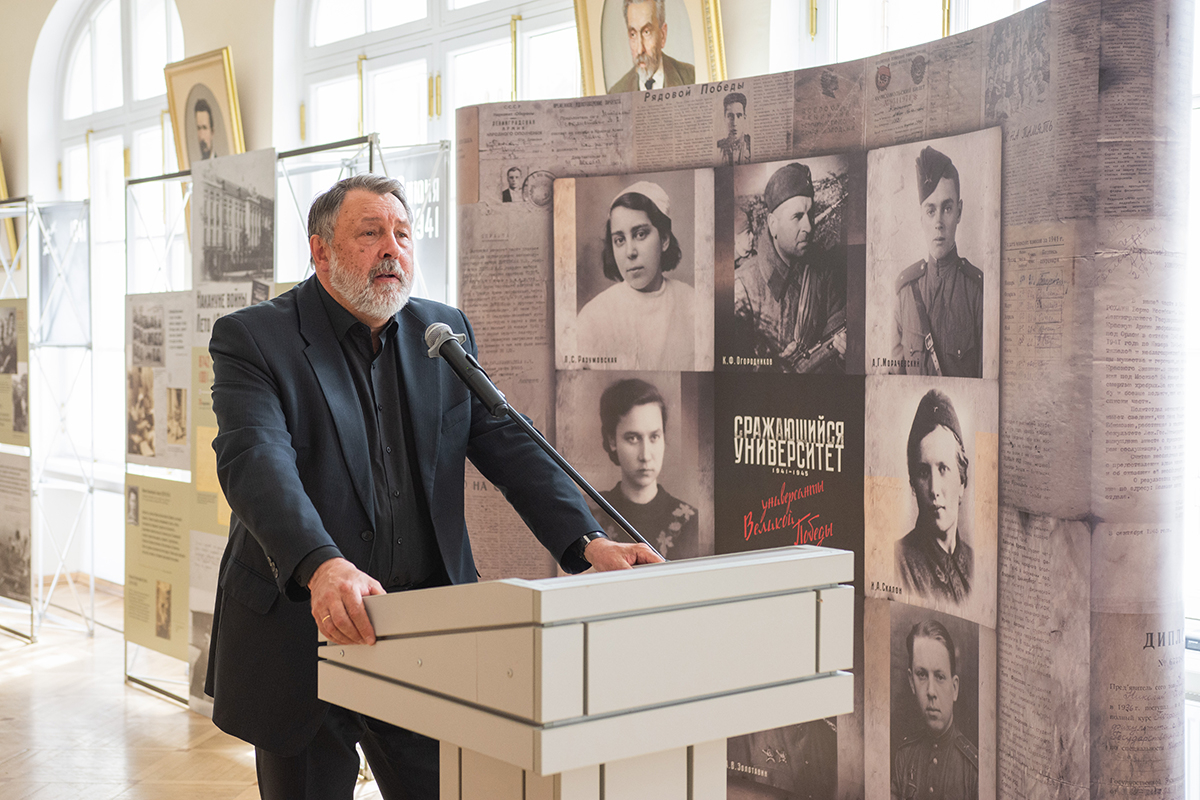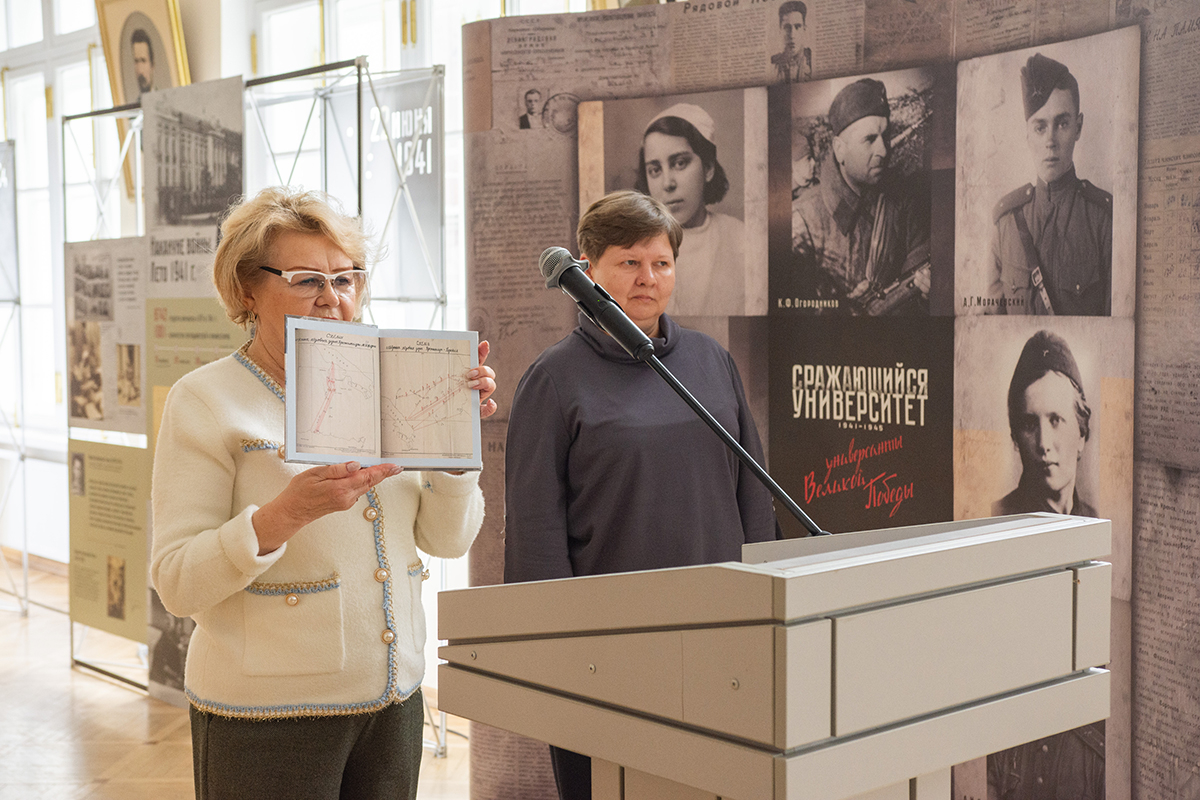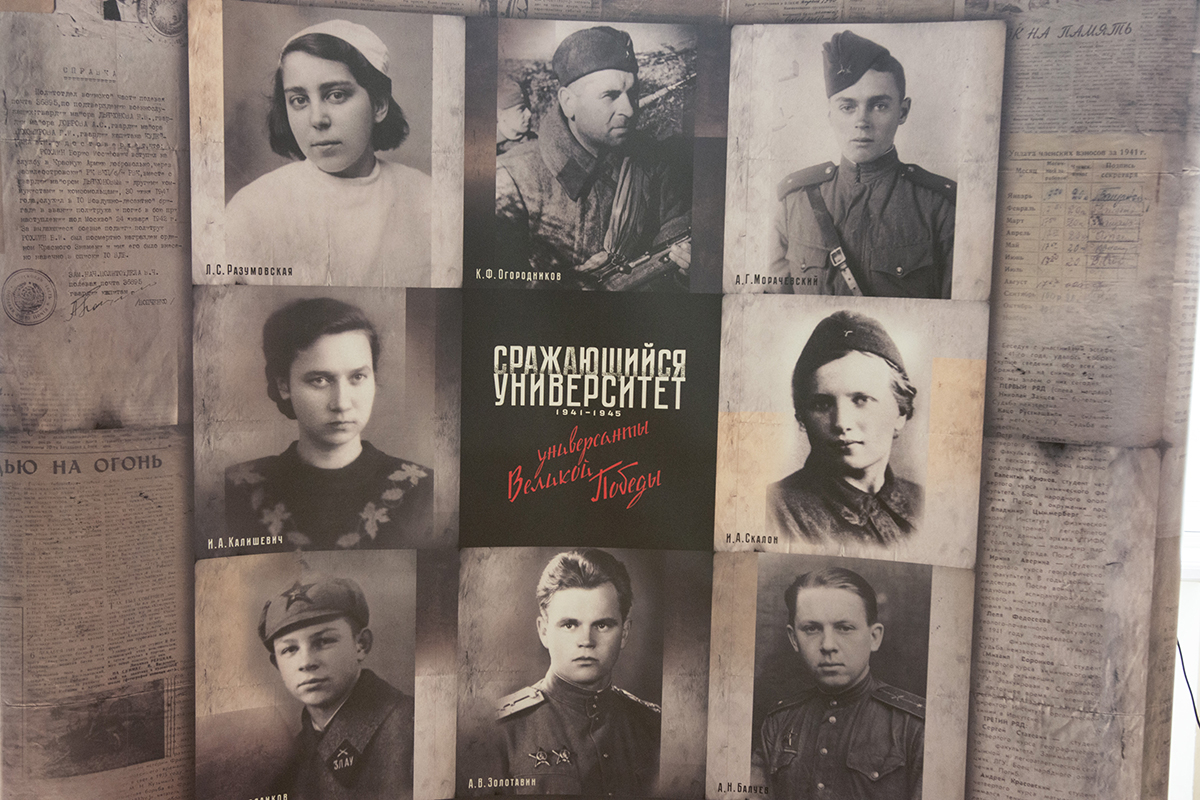An exhibition dedicated to the University’s feat during World War II at St Petersburg University
To celebrate the 80th anniversary of the Great Victory, St Petersburg University has opened an exhibition ‘The fighting University 1941-1945’. The exhibition features unique materials and documents from the collection of the St Petersburg University museums, some of which are being published for the first time. It also presents research results by St Petersburg University historians and the memoirs of the University’s staff and students who were veterans of the Great Patriotic War.
During the grand opening ceremony, Anastasia Yarmosh, Senior Vice-Rector for Strategic Development and Partnership at St Petersburg University, said that the exhibition dedicated to one of the milestones of the 20th century turned out to be very personal. As Nikolay Kropachev, Rector of St Petersburg University, emphasised at the ceremony of laying flowers at the monument ‘To the Immortality of the Deceased’, there are no people in Russia whose relatives were not affected by World War II. In those years, the University was like a big family. Although the University staff and students had different lives, yet scholars and students fought at the front or in partisan detachments, worked in the rear, conducted scientific work in Saratov, Yelabuga and in besieged Leningrad, and everyone was striving for only one thing — the victory.

‘The University began work on preserving the memory of World War II even before its end,’ said Anastasia Yarmosh. ‘For many years, St Petersburg University museologists and historians have been working to return the names of our heroes; the Ingria search team has been conducting field expeditions for a quarter of the century. Today, there is a war in the information field, so our experts, e.g. historians, economists and lawyers, are doing much to protect the historical truth. Once again, the University acts as a big family, continuing to cherish its history.’
In 2010, the St Petersburg University Publishing House released the collection ‘We know what the war means’, which included excerpts from the memoirs, letters and diaries of the University’s veterans. The collection of these materials began in 1943 in Saratov under the leadership of Professor Vladimir Mavrodin, Dean of the Faculty of History at Leningrad State University, and continued in the post-war years. Over the 15 years since the publication, University researchers have discovered many new materials that will be presented to visitors to the exhibition, said Igor Tikhonov, the scientific curator of the St Petersburg University History Museum and Professor in the Department of Archaeology at St Petersburg University.
‘This exhibition focuses on the most heroic and tragic page in the history of our University. The title of the exhibition is absolutely accurate, because the University did not just survive in those conditions. It fought. Students, postgraduates, and teachers fought on the fronts of World War II. Scientists worked for the needs of defence, made a number of important discoveries, and created many things necessary for industry’, said Igor Tikhonov. ‘The University made its contribution to the common Victory, the 80th anniversary of which we celebrate this year. Even many years later, these events will never be erased from the memory of the University’s staff and students.’
During the grand opening ceremony of the exhibition, Natalia Karalash, President of the interregional public organisation ‘Pilots of the Crown Service’, donated several copies of the book ‘Pilots of the Victory. 1941-1945’ to the M Gorky Scientific Library at St Petersburg University. The almanac contains biographies of 47 sailors who during World War II helped to guide ships through the Gulf of Finland and defend besieged Leningrad from the sea. Information about the participation of pilots in naval and army operations remained classified for 75 years, and thanks to the research conducted by the descendants of veterans during archival work, the University’s staff and students will learn more about this little-known page of Russian maritime history.
The exhibition ‘The fighting University 1941-1945’ consists of two parts. Posters in the corridor of the Twelve Collegia building will present all the key stages of life of Leningrad State University during World War II, i.e. the first days of the war, evacuation to Saratov and Yelabuga, work in besieged Leningrad, conducting research for the needs of the front, returning in 1944 and restoring the University, the Victory, preserving the memory of the war years at the present time.
In the exhibition hall, visitors can see authentic artefacts, i.e. a notebook with reviews and thanks from visitors to the wild plant exhibition that took place in the Botanical Garden at the University in 1943; a soldier’s tunic of a history student and later Professor of Leningrad State University Aleksandr Nemilov; an autobiography of Hero of the Soviet Union Ivan Kotov, who became the Head of the Department of Economic Cybernetics; front-line reports, food cards, diaries, certificates and other documents. The exhibition includes items from the collections of the St Petersburg University History Museum, the Museum of the History of Physics and Mathematics at St Petersburg University, the Mineralogical Museum at St Petersburg University, and publications from the collection of the M Gorky Scientific Library at St Petersburg University. Financial support for the project was provided by the company ‘Karavai’ (during World War II and the Siege, it was Bread Factory No 6 named after Alexei Badayev).
The initiative to create the St Petersburg University History Museum was proposed in 1939, when the staff of the M Gorky Scientific Library prepared an exhibition about the pre-revolutionary past and the latest achievements of the University for the 120th anniversary of Leningrad State University. While in evacuation, the University’s staff and students returned to this idea, and on 13 January 1945, a decision was made to establish one of the first university history museums in the country. Over 80 years, several generations of employees have created a unique museum collection at the University.
According to Ianina Strakhova, Head of the St Petersburg University History Museum, it was possible to create such an extensive collection at the University due to the fact that in 1947 a committee was created at Leningrad State University to collect memorabilia and fresh memories. University veterans or their widows brought letters, postcards, photographs, medals, and other personal items that were carefully preserved. Although the committee was dissolved in connection with the Leningrad affair and the documents from the archives were confiscated, some of them have survive. Today, St Petersburg University scholars continue to work on restoring a full picture of the University’s life during the war.
‘These papers and names hide entire stories. It often happens that we know the name of this or that person, but we do not know who they were. While going through the archives, we find new information: for example, we have recently learned that Vladimir Mavrodin, Professor of Leningrad State University, wrote letters from the evacuation to a student who remained in Leningrad along with the orphanage where she came to work at the request of her school teacher. Later, she was evacuated to the Gorky Region with the children. Vladimir Mavrodin continued writing letters to her. In his letters, he always wrote that she was welcomed at the University. We know that she returned to Leningrad, graduated from the Faculty of History and worked as a teacher for a long time,’ said Ianina Strakhova.
Our task was to paint a comprehensive picture, to show the fates of some of the University’s staff and students in a broad historical context, which always consists of the exploits of specific people and the efforts that each of them made. We can only admire the resilience of that generation.
Konstantin Shirko, Acting Head of the Department of Exhibitions and Collections at St Petersburg University
The exhibition ‘The fighting University 1941-1945’ is open until 30 June. It is open on weekdays from 11am to 5pm.
As part of the events dedicated to the 80th anniversary of the Victory in World War II, there was a screening of the documentary film ‘Architecture of the Siege’ in the reading room at the M. Gorky Scientific Library at St Petersburg University. The film centres on the stories of architects, artists, engineers, museum workers, and climbers who, remaining in the besieged city, made heroic efforts to preserve its architectural heritage.

‘The topic of the Siege of Leningrad is an inexhaustible source for researchers both in Russia and abroad. The volume of unstudied material relating to the Siege of Leningrad and the time preceding it remains significant. While working with archives, in particular with the materials collected by the daughter of a famous historian, we discovered unique methods that made it possible to preserve a great heritage in such a tragic period, under conditions of constant bombing,’ said Viktor Naumov, Head of the project ‘Preserved culture’, the author of the idea, the film’s producer, and a graduate of St Petersburg University.
According to the creators of the documentary film, the film shows the techniques used to protect the city’s cultural sites (the Peter and Paul Fortress, St Isaac’s Cathedral, and the Winter Palace) from German bombing, recreates the appearance of a ‘virtual’ Smolny and demonstrates methods of camouflaging bridges, train stations, industrial enterprises, and ships located in the Neva River.
The scriptwriter and director is Maksim Iakubson; the cameraman is Georgii Porotov; and the sound designers are Sergei Siniak, Pavel Gorskikh, Daria Blagikh, and Dmitrii Vasilev.
The film has been awarded a number of prizes. Among them are the following: the main prize ‘For the best documentary film’ at the 1st Open Russian Film Festival of Patriotic Cinema ‘Malaya Zemlya’ (Novorossiysk) and the Silver Badge of the Union of Architects of Russia (Moscow).














